Michael Andrew Confident on Road to Monumental Olympic Trials Test
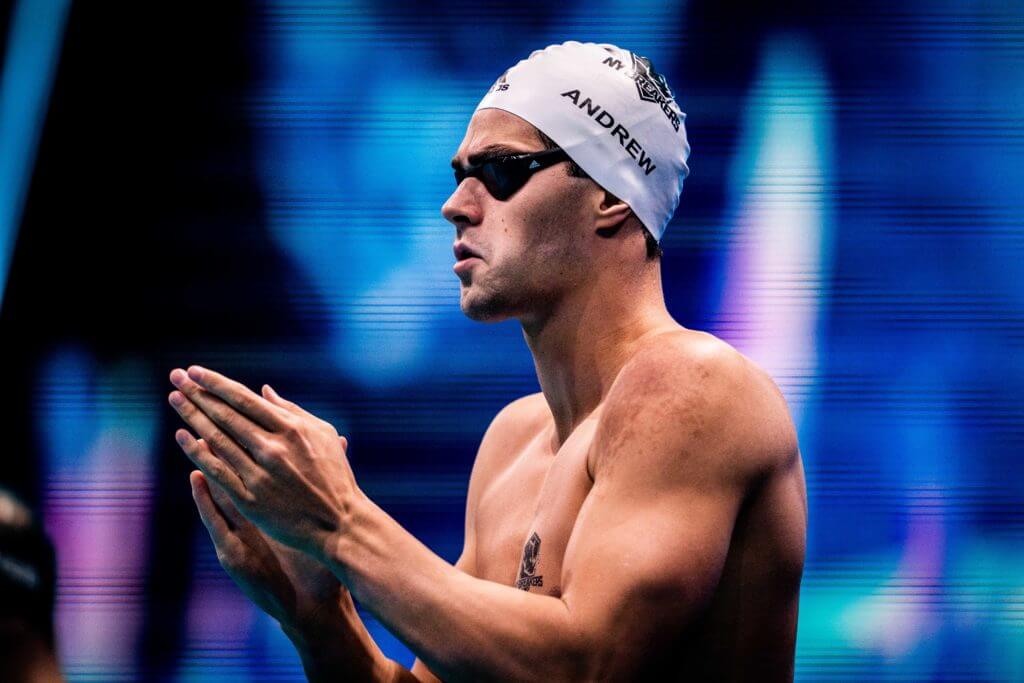
Editorial content for the 2021 Tokyo Olympic Games coverage is sponsored by GMX7.
See full event coverage. Follow GMX7 on Instagram at @GMX7training #gmx7

Michael Andrew Confident on Road to Monumental Olympic Trials Test
(From January’s Swimming World Magazine)
Michael Andrew has been the target of criticism the last seven-and-a-half years for his decision to turn pro at 14, his unique training style (USRPT), his training plan and more. But he’s also enjoyed success along the way and is ready to move to the next level as he prepares to qualify for the 2021 Olympics.
**********
Each time Michael Andrew has achieved success in his swimming career, criticisms and questions have followed. When he first became a professional swimmer at just 14 years old after breaking an endless stream of age group records, traditionalists slammed the move as improper. His training system became a constant matter of debate on pool decks. Some viewed Andrew as a swimming outcast, while others saw a teenager destined to become the world’s best swimmer.
As Andrew reached his late teens, he became one of the top junior-level swimmers in the United States, but his abilities to match up on the senior level came into doubt. Then, once he started having success on the senior level, the question became: “Could he be anything more than an exceptional talent in 50-meter races?”
Undoubtedly, Andrew has followed a career path much different than any other acclaimed American swimmer. His mother, Tina, is his agent and manager, and his coach is his father, Peter. The father-son duo swears by Ultra-Short Race-Pace Training (USRPT), seen for years in conventional wisdom as the complete antithesis of how every other swimmer trains (a faulty notion, if not entirely incorrect).
So close is the Andrew family that when Michael speaks about his own preparation and his own success, he uses the pronoun “we” instead of “I.” That “we” includes Michael, his parents and his younger sister, Michaela.
“Growing up, I’ve always kind of understood that I wouldn’t be in the position I am today if it weren’t for the team behind me. Really, that team mostly consists of my family, and so when I speak about what I’m doing in the sport or something I’m going to do, a competition I’m preparing for, it’s really us as a unit who are getting ready,” Andrew said. “It’s just very natural for me to refer to us as ‘we’ because I understand that we operate just as a team.”
While most club swimmers seek to build toward the NCAA level, Andrew prioritized breaking national age group records and then venturing out onto the World Cup circuit, where he wracked up wins and prize money. He prioritized a racing format, short course meters, that held little relevance to most of his American compatriots, and he actually won his first short course World title (100 IM in 2016 at Windsor) a full 18 months before qualifying for his first senior international team in long course. Along the way, Andrew accumulated numerous sponsorship deals that made him one of the more profitable swimmers in the country, even while he was a teenager.
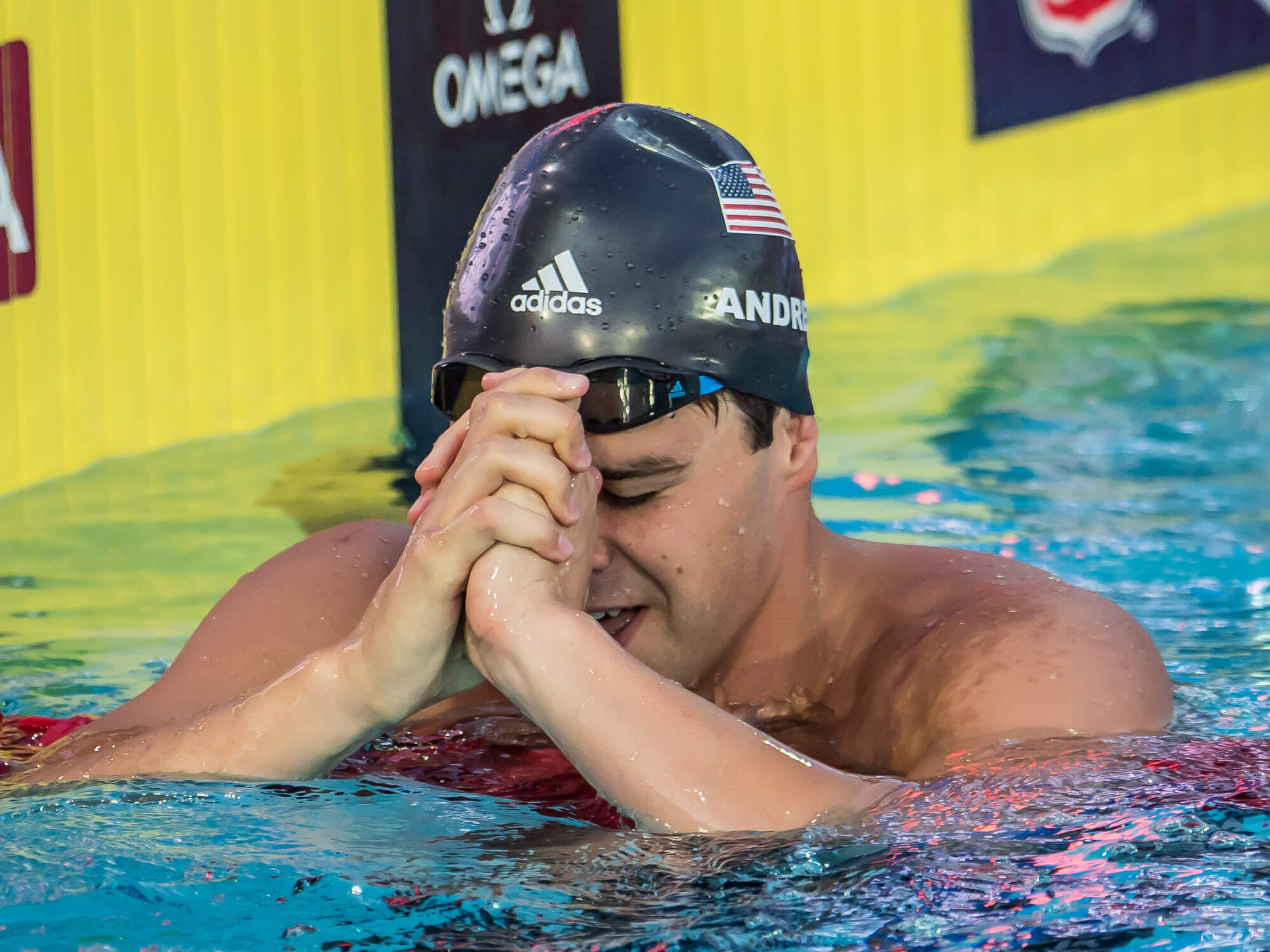
Michael Andrew celebrates winning his first U.S. national title in 2018 — Photo Courtesy: Peter H. Bick
And then, when the then-19-year-old Andrew won his first U.S. national title in 2018, much of the swimming community shrugged off the accomplishment since it came in the non-Olympic race 50 fly—even if he did beat out Caeleb Dressel in the process! But Andrew kept winning, with a national title each of four straight nights—and each win brought him further validation and vindication. That included a U.S. Open record in the 50 breast, first place in a deep 100 breast heat (his first national title in an Olympic event) and a dominant victory over Dressel in the 50 free.
“I do feel like this is kind of the kickstart of my adult professional career,” Andrew said that week. “It’s the first official long course international team that I’ve made, so I definitely think it gives me a lot of credibility, especially with the way we train being so different: race-pace, all short. It just goes to show that it works, and there’s different ways to do things.”
A few weeks later, Andrew won his first-ever senior-level international gold at the Pan Pacific Championships, and his time of 21.46 bested Dressel by nearly a half-second and ranked Andrew as the sixth-fastest swimmer in the world for 2018.
Questions remained, sure… like “How did Andrew’s event schedule fit together?” But Andrew had finally established himself firmly as an international force in a long course Olympic event.
Michael Andrew: Be the Best in Everything?
At 2018 Nationals, Andrew faced the question of what was his best stroke, but he would not commit to just one or two. “I could never put that label on myself,” he said. “I will always swim all strokes. I definitely think there’s seasons where one stroke may be more dominant than the others, but the goal is to be the best in the world in all four strokes in the 50s, and then the 100s can come after that.”
And in 2019, he was absolutely among the best in the world at all four strokes in the 50s. At the FINA World Championships in Gwangju, he became the first swimmer ever to make the final in all four, and his highest finish was fourth, just 1-hundredth out of the medals in the 50 fly. He also finished fifth in the 50 back, sixth in the 50 free, seventh in the 50 breast and a relatively disappointing 19th in the 100 breast. He did earn a silver medal as a prelims medley relay swimmer.
More ammo in the tank for the “Michael Andrew is just a 50s swimmer” crowd? Yes, but his swims in the early parts of 2020 would shift the narrative again, setting up Andrew as potentially a major force for the American team heading into the Tokyo Olympics.
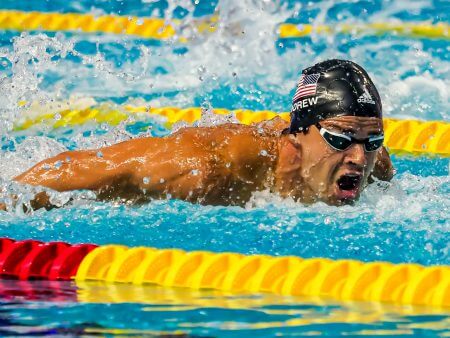
Michael Andrew swimming butterfly in 2019 — Photo Courtesy: Peter H. Bick
At the TYR Pro Swim Series in Des Moines, Iowa, Andrew swam lifetime best times in three events, none of them 50 meters in length: 59.14 in the 100 meter breast, 51.33 in the 100 fly and 1:56.83 in the 200 IM. His 100 breast made him the seventh-fastest man in U.S. history, and his 200 IM moved him up to sixth in the all-time domestic rankings. That built up some serious momentum heading into the Olympic summer, but within days, the country began to shut down as COVID-19 spread… and within weeks, the Olympics had been postponed to 2021.
Andrew had grown up in Kansas and trained in a two-lane backyard pool, but his family moved to Encinitas, Calif., in late 2018. No longer armed with their own pool, the COVID shutdown put Andrew out of the pool for almost two months. Gifted with a mental break from the pool, Andrew spent time surfing and playing volleyball and building relationships. While so many have dealt with loneliness during the pandemic, Andrew experienced emotional growth.
“It was an interesting year, but looking back on it, I’m really, really grateful because we had extra time to prepare mentally. And I think it was really special, really a season that I needed in terms of creating community and doing things like that,” Andrew said. “We really kind of stepped back 100% from the pool and decided, ‘We’ll take this season to be away from the pool and focus on strengths and just enjoying the paradise we live in.’”
Learning From the ISL Experience
Given Andrew’s extensive experience and success in short course meters racing, it was no stretch to expect that he would be one of the stars of the International Swimming League. When the first eight ISL teams were announced in 2019, the Andrew family put their stamp on one, the New York Breakers, with Tina announced as general manager and Michael as team captain. But in 2020, when the ISL’s six-week bubble in Budapest turned out to be the year’s only major swimming competition, Andrew failed to make a significant impact.
Andrew swam five individual events (plus sometimes skins) in each of the five meets in which the Breakers competed, but he finished in the top three just nine times all season. And his lone win came in the 100 IM in the semifinal, his last meet. Even in the 50 free, he was not competitive with the likes of Dressel and Florent Manaudou, and he didn’t make any impact in the skins elimination races.
“I think I swam decent considering where we were in training,” Andrew said. “I was very physically unready, which was unfortunate, and it was something that we just couldn’t control. I swam to my potential in terms of what I had prepared for, but leading up to it—and I don’t want to make any excuses—it was just a very weird year in terms of training. I did what I could with what I had physically.”
So what happened to Andrew last year?
He admitted that prior to arriving in the bubble, he made a rare but significant change in his training. During a training trip in Turkey, he swam “purely traditional” practices after struggling to hit his paces for several weeks.
“What I realized from looking back on that is I need to be conditioning all via pace,” he said. “I believe in pure USRPT.”
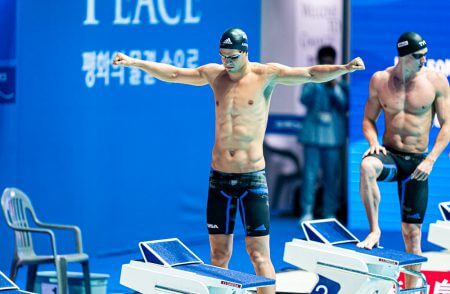
Michael Andrew at the 2019 FINA World Championships — Photo Courtesy: Becca Wyant
But “pure USRPT” doesn’t mean just 25s, and it doesn’t mean all that short, either. Andrew said that for the foreseeable future, including the leadup to the rescheduled U.S. Olympic Trials in June, his morning practices will be “long,” consisting of 4500 to 5000 meters of 200-pace efforts, with easy warm-up and recovery in between. A practice might consist of a 200 fly set, a 200 free set and then a 200 IM set, working 75s and 50s with 20 seconds rest in between. At maximum, a single set might stretch to 30 x 50. Afternoon doubles practices would incorporate 100 pace and speed.
Andrew believes those grueling pace sets, spending upwards of 20 minutes straight at race pace with no recovery, build the endurance required to successfully complete 100-meter races and the 200 IM. Long race-pace sets are staples of swim training programs throughout the country, but the difference with Andrew’s training is his exclusivity to USRPT. However, when he broke through at U.S. Nationals in 2015, Andrew described his training sessions as “2,500 to 3,000 meters max” and never much more. Now, the distance and length of intense swimming has increased, and Andrew has noticed significant payoffs.
“When I was my most physically fit and finished my races the best—like when I went my 1:56 in March—I was doing a lot of 200 butterfly sets,” Andrew said. “For that, I was mentally confident that if I can get 30 x 50 on a certain pace butterfly, and I can finish any race. Sure enough, I was able to step up and be able to do it.”
And, in another change from his 2018 stance, Andrew had no equivocations about his primary event focuses heading into the Olympic summer: the 200 IM, 100 breast and 50 free. Two years of racing on the senior international level showed Andrew what he does best. He and his father may choose to add another event or two—the 100 fly or possibly the 100 free—but the training will center around those first three events. And should Andrew return to the form that saw him shine at the Des Moines Pro Series meet in March or at Pan Pacs back in 2018, he will undoubtedly be among the short list of contenders for U.S. Olympic team spots in all three of those races.
Michael Andrew Swimming with No Regrets
When Andrew turned pro at 14, he was committed to his path: there would be no changing his mind and trying to regain his eligibility for high school or NCAA competition. Now, seven-and-a-half years down the line, Andrew expresses no regrets, but sometimes, like during a period when he’s not performing at his best, he wonders what the alternative path would have looked like.
“I would have probably gone to the University of Texas,” he said. “I have a lot of friends out there. I know they have a really good group, a lot of guys who really push each other. I wonder sometimes, ‘What would I be doing in terms of the training or the events? Would my event lineup be completely different? Maybe I would be a 400 IMer?’ Those types of things.
“But I never regret it because I realize, man, I’ve had an incredible career up to now, but I also just love the opportunities that I’ve been blessed with through going pro and being able to travel and the freedoms that I’ve been given, just in terms of being able to create our own brand.”
Andrew believes that other athletes and coaches, inspired by his success, became more comfortable deviating from more traditional methods of training, and he has been encouraged seeing those athletes achieving success. Yes, he knows he missed out on the team atmosphere, camaraderie and relays that come from the NCAA swimming experience, but he has enjoyed seeing those elements of swimming elsewhere—with the New York Breakers and with the U.S. national team.
But with the decision to follow a very different direction for his swimming career came criticism, and Andrew and his family have dealt with plenty of feedback and criticism over the years. These days, Andrew finds most of the chatter he reads positive and encouraging, but previously, he had to learn how to filter out negative chatter so that it didn’t affect him.
“When I was younger, I enjoyed reading the comments section and seeing what people had to say. A lot of times it was snarky or negative or would break me down a little bit in terms of who I am as an athlete. And that’s people making judgments off of no basis. They didn’t know who I was. And then it’s cool to see that over the years, as people got to know me, it’s turned more positive than negative,” Andrew said.
“I never wanted to use negative criticism as a means to motivate myself when training. I definitely would feed off of it a lot of times in the right light, but I realized I had to stop kind of looking at it. As I obviously matured and got older, I realized that I don’t need to give any attention to what somebody so far out of my circle has to say because ultimately, their input isn’t going to make a difference.”
Expecting Great Things
Today, Andrew is 21, and he is a good-natured and insightful individual, but to many disconnected observers around the swimming community, “Andrew the Swimmer” remains a polarizing figure—if only because of his unorthodox background and the nonconforming decisions that have steered his career. Considering the normal standards by which swimming careers are judged, he is already one of the country’s top swimmers, with a chance to cement that by earning his first Olympic berth.
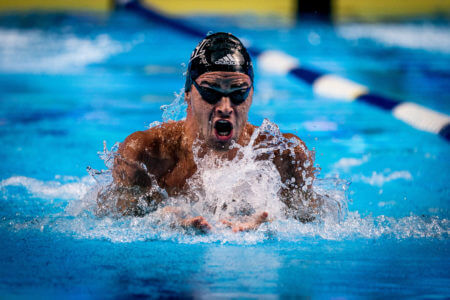
Michael Andrew during the 2020 ISL season — Photo Courtesy: Mine Kasapoglu / ISL
However, when Andrew mentioned Dressel—named MVP of the ISL final for a second consecutive year after breaking world records in the 50 free, 100 fly and 100 IM and winning all five of his individual events in the final—he commented, “I know I’m meant to be there,” referring to Dressel’s level of superstardom. But at this point, he is not at the tip-top of the world’s elite, the gold-medal level. Even if it’s unfair to expect that level of achievement from a 21-year-old, however long he has been in swimming’s spotlight, Andrew seems to expect that of himself.
Swimmers’ careers are most commonly judged by their accomplishments at the Olympic level and, to a lesser extent, at the long course World Championships, and that’s a level Andrew has not yet conquered. So the 2021 Olympic season represents a key juncture in his career, even if his unconventional path has allowed Andrew to achieve massive successes totally separate from that Olympics-centered path, including the World Cup and short course wins, numerous high-value sponsorship deals and family control of one of the original ISL teams.
“I feel a little more pressure personally this year because I had a great season in 2018, and then 2019 was pretty rocky, and then 2020 was pretty nonexistent,” Andrew said. “I’m at a point where I want to really solidify myself as a swimmer capable of showing up when it really matters. I know I have to do it now, so there’s a little more pressure there.”
So, yes, Michael Andrew is a swimming star, just not quite in the same mold as a Dressel, a Sarah Sjostrom, a Katie Ledecky or an Adam Peaty—those with numerous world records and gold medals. But his biggest chance yet to test himself on that Olympic level is quickly approaching, and Andrew is certain he will be ready.





I enjoyed your Rtical about Michael
I always felt too many people had too many opinions about Michael growing up. He and his family did what they felt best for him. Who’s to say what is right or wrong.?
I applaud the Andrews family on knowing what is best for their family, and their success as a whole. Can’t wait to see what they will do in June 2021.
I agree!! Nothing wrong with standing up for what you believe!! Know the family personally!! Super transparent and so real!!!